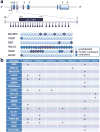Deregulation of α-synuclein in Parkinson's disease: Insight from epigenetic structure and transcriptional regulation of SNCA
- PMID: 28445713
- PMCID: PMC5557282
- DOI: 10.1016/j.pneurobio.2017.04.004
Deregulation of α-synuclein in Parkinson's disease: Insight from epigenetic structure and transcriptional regulation of SNCA
Abstract
Understanding regulation of α-synuclein has long been a central focus for Parkinson's disease (PD) researchers. Accumulation of this protein in the Lewy body or neurites, mutations in the coding region of the gene and strong association of α-synuclein encoding gene multiplication (duplication/triplication) with familial form of PD have indicated the importance of this molecule in pathogenesis of the disease. Several years of research identified many potential faulty pathways associated with accumulation of α-synuclein inside dopaminergic neurons and its transmission to neighboring ones. Concurrently, an appreciable body of research is growing to understand the epigenetic and genetic deregulation of α-synuclein that might contribute to the disease pathology. Completion of the ENCODE (Encyclopedia of DNA Elements) project and recent advancement made in the epigenetic and trans factor mediated regulation of each gene, has tremendously accelerated the need to carefully understand the epigenetic structure of the gene (SNCA) encoding α-synuclein protein in order to decipher the regulation and contribution of α-synuclein to the pathogenesis of PD. We have also analyzed the detailed epigenetic structure of this gene with knowledge from ENCODE database, which may open new avenues in α-synuclein research. Interestingly, we have found that the gene contains several transcriptionally activate histone modifications and associated potential transcription factor binding sites in the non-coding areas that strongly suggest alternative regulatory pathways. Altogether this review will provide interesting insight of α-synuclein gene regulation from epigenetic, genetic and post-transcriptional perspectives and their potential implication in the PD pathogenesis.
Keywords: DNA methylation; Epigenetics; Gene regulation; Histone post translational modification; Parkinson's disease; α-synuclein.
Copyright © 2017 Elsevier Ltd. All rights reserved.
Conflict of interest statement
The authors declare no conflicts of interests
Figures



Similar articles
-
Hypomethylation of intron1 of α-synuclein gene does not correlate with Parkinson's disease.Mol Brain. 2017 Feb 7;10(1):6. doi: 10.1186/s13041-017-0285-z. Mol Brain. 2017. PMID: 28173842 Free PMC article.
-
Unraveling the Complex Interplay between Alpha-Synuclein and Epigenetic Modification.Int J Mol Sci. 2023 Apr 2;24(7):6645. doi: 10.3390/ijms24076645. Int J Mol Sci. 2023. PMID: 37047616 Free PMC article. Review.
-
The yin and yang of α-synuclein-associated epigenetics in Parkinson's disease.Brain. 2017 Apr 1;140(4):878-886. doi: 10.1093/brain/aww227. Brain. 2017. PMID: 27585855
-
Targeted attenuation of elevated histone marks at SNCA alleviates α-synuclein in Parkinson's disease.EMBO Mol Med. 2021 Feb 5;13(2):e12188. doi: 10.15252/emmm.202012188. Epub 2021 Jan 11. EMBO Mol Med. 2021. PMID: 33428332 Free PMC article.
-
DNA methylation in Parkinson's disease.J Neurochem. 2016 Oct;139 Suppl 1:108-120. doi: 10.1111/jnc.13646. Epub 2016 Jun 10. J Neurochem. 2016. PMID: 27120258 Review.
Cited by
-
Lifetime Impact of Cow's Milk on Overactivation of mTORC1: From Fetal to Childhood Overgrowth, Acne, Diabetes, Cancers, and Neurodegeneration.Biomolecules. 2021 Mar 9;11(3):404. doi: 10.3390/biom11030404. Biomolecules. 2021. PMID: 33803410 Free PMC article. Review.
-
Interplay between the glymphatic system and neurotoxic proteins in Parkinson's disease and related disorders: current knowledge and future directions.Neural Regen Res. 2024 Sep 1;19(9):1973-1980. doi: 10.4103/1673-5374.390970. Epub 2023 Dec 15. Neural Regen Res. 2024. PMID: 38227524 Free PMC article.
-
Neuronal-type-specific epigenome editing to decrease SNCA expression: Implications for precision medicine in synucleinopathies.Mol Ther Nucleic Acids. 2023 Nov 24;35(1):102084. doi: 10.1016/j.omtn.2023.102084. eCollection 2024 Mar 12. Mol Ther Nucleic Acids. 2023. PMID: 38130373 Free PMC article.
-
Epigenetics and Neurological Disorders in ART.Int J Mol Sci. 2019 Aug 26;20(17):4169. doi: 10.3390/ijms20174169. Int J Mol Sci. 2019. PMID: 31454921 Free PMC article. Review.
-
Using induced pluripotent stem cell neuronal models to study neurodegenerative diseases.Biochim Biophys Acta Mol Basis Dis. 2020 Apr 1;1866(4):165431. doi: 10.1016/j.bbadis.2019.03.004. Epub 2019 Mar 18. Biochim Biophys Acta Mol Basis Dis. 2020. PMID: 30898538 Free PMC article. Review.
References
-
- Ai SX, Xu Q, Hu YC, Song CY, Guo JF, Shen L, Wang CR, Yu RL, Yan XX, Tang BS. Hypomethylation of SNCA in blood of patients with sporadic Parkinson’s disease. Journal of the neurological sciences. 2014;337:123–128. - PubMed
-
- Appel-Cresswell S, Vilarino-Guell C, Encarnacion M, Sherman H, Yu I, Shah B, Weir D, Thompson C, Szu-Tu C, Trinh J, Aasly JO, Rajput A, Rajput AH, Jon Stoessl A, Farrer MJ. Alpha-synuclein p.H50Q, a novel pathogenic mutation for Parkinson’s disease. Movement disorders : official journal of the Movement Disorder Society. 2013;28:811–813. - PubMed
-
- Baylin SB. DNA methylation and gene silencing in cancer. Nat Clin Pract Oncol. 2005;2(Suppl 1):S4–11. - PubMed
Publication types
MeSH terms
Substances
Grants and funding
LinkOut - more resources
Full Text Sources
Other Literature Sources
Medical
Miscellaneous

